PEP人教版五年级下册英语Unit 1 My day第二课时教案
人教PEP版-英语-五年级下册-原创Unit1My day!第2课时教案
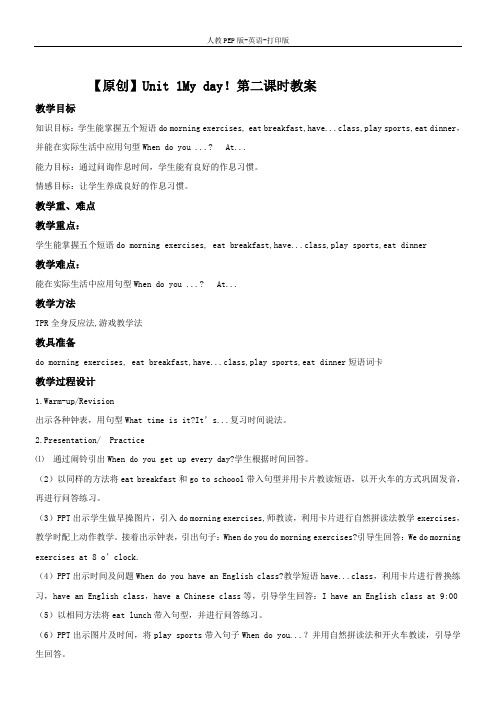
【原创】Unit 1My day!第二课时教案教学目标知识目标:学生能掌握五个短语do morning exercises, eat breakfast,have...class,play sports,eat dinner,并能在实际生活中应用句型When do you ...? At...能力目标:通过问询作息时间,学生能有良好的作息习惯。
情感目标:让学生养成良好的作息习惯。
教学重、难点教学重点:学生能掌握五个短语do morning exercises, eat breakfast,have...class,play sports,eat dinner教学难点:能在实际生活中应用句型When do you ...? At...教学方法TPR全身反应法,游戏教学法教具准备do morning exercises, eat breakfast,have...class,play sports,eat dinner短语词卡教学过程设计1.Warm-up/Revision出示各种钟表,用句型What time is it?It’s...复习时间说法。
2.Presentation/ Practice⑴通过闹铃引出When do you get up every day?学生根据时间回答。
(2)以同样的方法将eat breakfast和go to schoool带入句型并用卡片教读短语,以开火车的方式巩固发音,再进行问答练习。
(3)PPT出示学生做早操图片,引入do morning exercises,师教读,利用卡片进行自然拼读法教学exercises,教学时配上动作教学。
接着出示钟表,引出句子:When do you do morning exercises?引导生回答:We do morning exercises at 8 o’clock.(4)PPT出示时间及问题When do you have an English class?教学短语have...class,利用卡片进行替换练习,have an English class,have a Chinese class等,引导学生回答:I have an English class at 9:00 (5)以相同方法将eat lunch带入句型,并进行问答练习。
五年级下册英语教案-Unit 1 my day 第二课时_人教(PEP)(2014秋)

第二课时教学目标1.听、说、读、写短语:do morning exercises, eat breakfast, have … class, play sports, eat dinner。
2.进一步巩固句型:—When do you do morning exercises/get up/ eat breakfast/…?—I do morning exercises/get up/eat breakfast/… at seven o'clock.3.培养学生合作学习和自学的能力并养成规律作息的好习惯。
教学重点1.掌握短语:do morning exercises, eat breakfast, have … class, eat dinner。
2.能用短语和句型与同伴进行对话交流。
教学难点1.掌握exercises的拼写和读音。
2.能和同伴进行对话练习。
3.能熟练地用英语表达时间点。
教学准备教师准备:1.与本课时相关的单词卡片与图片。
2.与本课时相关的录音和课件、一个时钟。
学生准备:1.本课所需单词卡片。
2.动词短语的图片或某个动作的照片。
3.时钟。
4.自己的时间与活动的安排表。
教学方法1.表演教学法教师把动词短语do morning exercises, eat breakfast, have … class, play sports, eat dinner写在黑板上,分别找同学到前面用自己的肢体语言或相应的面部表情或动作表达出来,学生猜一猜,这样使英语的学习过程更具趣味性。
2.任务教学法教师制作一个简单的调查表:When do you get up/eat breakfast/eat lunch/eat dinner/do morning exercises/have English class/play sports/go to bed?学生根据自己的实际情况回答,完成调查表。
人教PEP版-英语-五年级下册--Unit 1 My day 第二课时教案
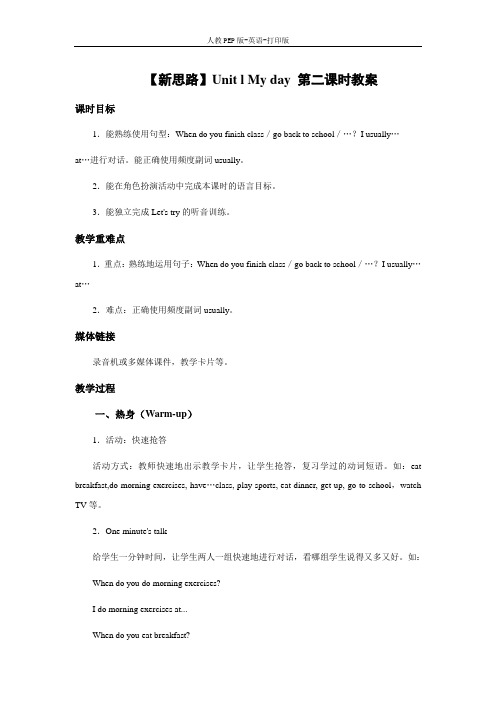
【新思路】Unit l My day 第二课时教案课时目标1.能熟练使用句型:When do you finish class/go back to school/…?I usually…at…进行对话。
能正确使用频度副词usually。
2.能在角色扮演活动中完成本课时的语言目标。
3.能独立完成Let's try的听音训练。
教学重难点1.重点:熟练地运用句子:When do you finish class/go back to school/…?I usually…at…2.难点:正确使用频度副词usually。
媒体链接录音机或多媒体课件,教学卡片等。
教学过程一、热身(Warm-up)1.活动:快速抢答活动方式:教师快速地出示教学卡片,让学生抢答,复习学过的动词短语。
如:eat breakfast,do morning exercises, have…class, play sports, eat dinner, get up, go to school,watch TV等。
2.One minute's talk给学生一分钟时间,让学生两人一组快速地进行对话,看哪组学生说得又多又好。
如:When do you do morning exercises?I do morning exercises at...When do you eat breakfast?I eat breakfast at~3.活动:“月光宝盒”活动方式:教师出示事先准备好的两个盒子:标有“Activity”的盒子里放一些活动类的词组,如:eat breakfast,have…class,play sports,do morning exercises, eat dinner,标有“Time”的盒子里放入一些时间类的词组,如:at three o'clock,at nlne p.m.,at eight a.m.请一位学生在两个盒子里分别抽出一张纸条,然后大声地说出所拼成的句子。
人教PEP版英语五年级下册Unit 1 My day教学教案
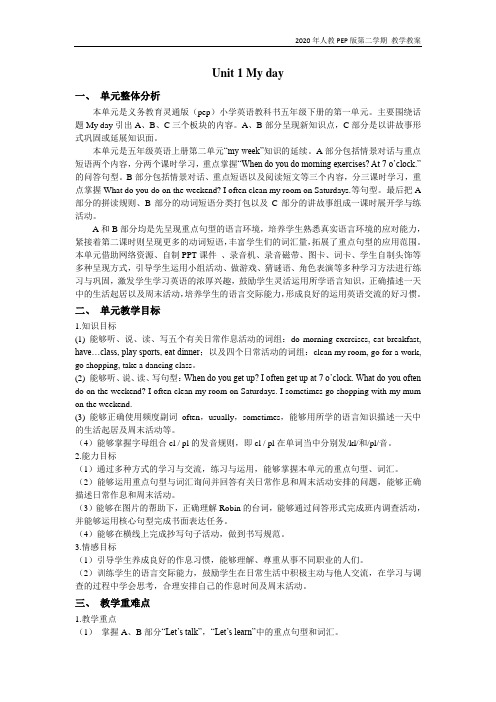
Unit 1 My day一、单元整体分析本单元是义务教育灵通版(pep)小学英语教科书五年级下册的第一单元。
主要围绕话题My day引出A、B、C三个板块的内容。
A、B部分呈现新知识点,C部分是以讲故事形式巩固或延展知识面。
本单元是五年级英语上册第二单元“my week”知识的延续。
A部分包括情景对话与重点短语两个内容,分两个课时学习,重点掌握“When do you do morning exercises? At 7 o’clock.”的问答句型。
B部分包括情景对话、重点短语以及阅读短文等三个内容,分三课时学习,重点掌握What do you do on the weekend? I often clean my room on Saturdays.等句型。
最后把A 部分的拼读规则、B部分的动词短语分类打包以及C部分的讲故事组成一课时展开学与练活动。
A和B部分均是先呈现重点句型的语言环境,培养学生熟悉真实语言环境的应对能力,紧接着第二课时则呈现更多的动词短语,丰富学生们的词汇量,拓展了重点句型的应用范围。
本单元借助网络资源、自制PPT课件、录音机、录音磁带、图卡、词卡、学生自制头饰等多种呈现方式,引导学生运用小组活动、做游戏、猜谜语、角色表演等多种学习方法进行练习与巩固,激发学生学习英语的浓厚兴趣,鼓励学生灵活运用所学语言知识,正确描述一天中的生活起居以及周末活动,培养学生的语言交际能力,形成良好的运用英语交流的好习惯。
二、单元教学目标1.知识目标(1) 能够听、说、读、写五个有关日常作息活动的词组:do morning exercises, eat breakfast, have…class, play sports, eat dinner;以及四个日常活动的词组:clean my room, go for a work, go shopping, take a dancing class。
五年级英语下册Unit1MydayPartA第二课时教案1人教PEP
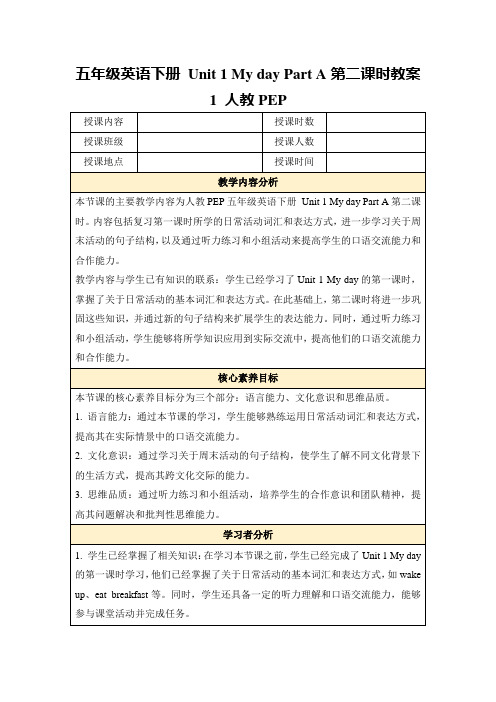
b.《21世纪报》中的报道《周末活动如何用英语表达》。
2.课后自主学习和探究:
a.鼓励学生在家中尝试用英语描述自己的日常活动和周末活动,并记录下来。
b.学生可以尝试寻找其他与日常活动和周末活动相关的英语表达方式,如歌曲、电影、故事等。
c.学生可以组成小组,通过社交媒ቤተ መጻሕፍቲ ባይዱ或邮件交流彼此的表达方式,互相学习和纠正。
五、总结回顾(用时5分钟)
今天的学习,我们了解了如何用英语描述日常活动和周末活动。同时,我们也通过实践活动和小组讨论加深了对这些表达方式的理解。我希望大家能够掌握这些知识点,并在日常生活中灵活运用。最后,如果有任何疑问或不明白的地方,请随时向我提问。
拓展与延伸
1.拓展阅读材料:为了让学生更深入地了解日常活动和周末活动的表达方式,我推荐以下两篇阅读材料:
d.学生可以尝试用英语制定一周的活动计划,并将其分享给同学或老师。
e.学生可以阅读英语故事书或小说,关注故事中人物的活动安排和描述方式。
板书设计
①本节课的重点知识点:
-日常活动和周末活动的英语表达方式
-描述活动的句子结构
-听力练习和小组活动
②关键词汇:
- Wake up
- Eat breakfast
e.课堂总结:教师邀请学生分享他们在小组活动中的收获,总结课堂所学内容。
3.教学媒体和资源:本节课将使用PPT、图片和录音机等教学媒体和资源。PPT用于展示教材内容和示范句子,图片用于引导学生学习关于周末活动的句子结构,录音机用于播放听力材料,帮助学生提高听力理解能力。
a.教师利用PPT呈现教材内容,引导学生跟读和模仿,确保正确掌握新句型。
人教版PEP英语五年级下册《Unit1MydayPartB》(第二课时)教学设计
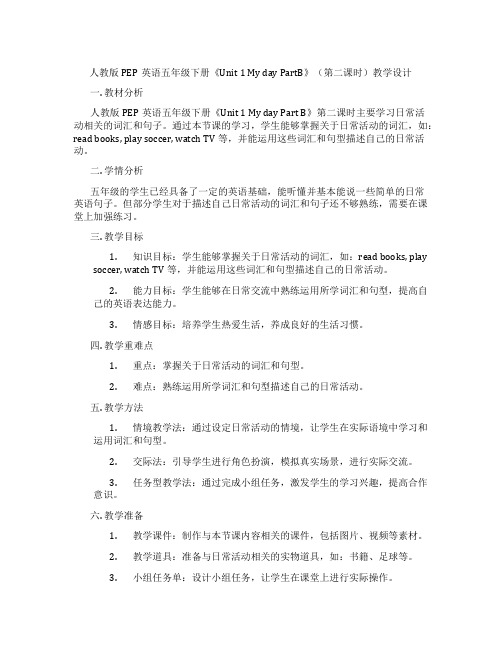
人教版PEP英语五年级下册《Unit 1 My day PartB》(第二课时)教学设计一. 教材分析人教版PEP英语五年级下册《Unit 1 My day Part B》第二课时主要学习日常活动相关的词汇和句子。
通过本节课的学习,学生能够掌握关于日常活动的词汇,如:read books, play soccer, watch TV等,并能运用这些词汇和句型描述自己的日常活动。
二. 学情分析五年级的学生已经具备了一定的英语基础,能听懂并基本能说一些简单的日常英语句子。
但部分学生对于描述自己日常活动的词汇和句子还不够熟练,需要在课堂上加强练习。
三. 教学目标1.知识目标:学生能够掌握关于日常活动的词汇,如:read books, playsoccer, watch TV等,并能运用这些词汇和句型描述自己的日常活动。
2.能力目标:学生能够在日常交流中熟练运用所学词汇和句型,提高自己的英语表达能力。
3.情感目标:培养学生热爱生活,养成良好的生活习惯。
四. 教学重难点1.重点:掌握关于日常活动的词汇和句型。
2.难点:熟练运用所学词汇和句型描述自己的日常活动。
五. 教学方法1.情境教学法:通过设定日常活动的情境,让学生在实际语境中学习和运用词汇和句型。
2.交际法:引导学生进行角色扮演,模拟真实场景,进行实际交流。
3.任务型教学法:通过完成小组任务,激发学生的学习兴趣,提高合作意识。
六. 教学准备1.教学课件:制作与本节课内容相关的课件,包括图片、视频等素材。
2.教学道具:准备与日常活动相关的实物道具,如:书籍、足球等。
3.小组任务单:设计小组任务,让学生在课堂上进行实际操作。
七. 教学过程1.导入(5分钟)利用图片或视频展示日常活动的场景,引导学生进行思考,引出本节课的主题。
2.呈现(10分钟)教师展示日常活动的词汇和句型,如:read books, play soccer, watch TV等,并进行解释和示范。
人教PEP版英语五年级下册Unit1《MyDay》全单元课时说课稿
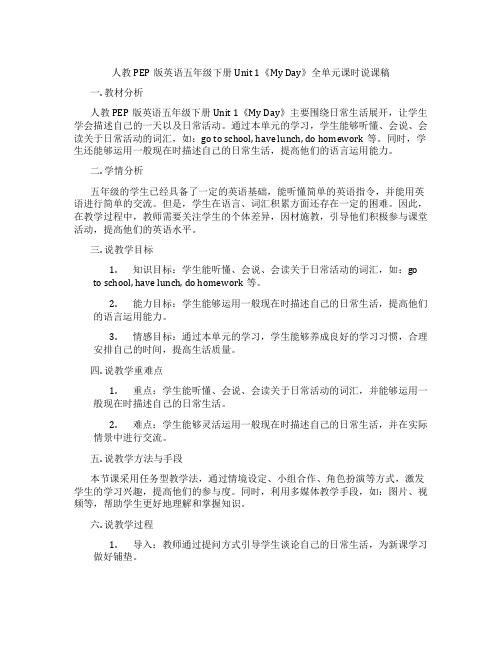
人教PEP版英语五年级下册Unit 1《My Day》全单元课时说课稿一. 教材分析人教PEP版英语五年级下册Unit 1《My Day》主要围绕日常生活展开,让学生学会描述自己的一天以及日常活动。
通过本单元的学习,学生能够听懂、会说、会读关于日常活动的词汇,如:go to school, have lunch, do homework等。
同时,学生还能够运用一般现在时描述自己的日常生活,提高他们的语言运用能力。
二. 学情分析五年级的学生已经具备了一定的英语基础,能听懂简单的英语指令,并能用英语进行简单的交流。
但是,学生在语言、词汇积累方面还存在一定的困难。
因此,在教学过程中,教师需要关注学生的个体差异,因材施教,引导他们积极参与课堂活动,提高他们的英语水平。
三. 说教学目标1.知识目标:学生能听懂、会说、会读关于日常活动的词汇,如:goto school, have lunch, do homework等。
2.能力目标:学生能够运用一般现在时描述自己的日常生活,提高他们的语言运用能力。
3.情感目标:通过本单元的学习,学生能够养成良好的学习习惯,合理安排自己的时间,提高生活质量。
四. 说教学重难点1.重点:学生能听懂、会说、会读关于日常活动的词汇,并能够运用一般现在时描述自己的日常生活。
2.难点:学生能够灵活运用一般现在时描述自己的日常生活,并在实际情景中进行交流。
五. 说教学方法与手段本节课采用任务型教学法,通过情境设定、小组合作、角色扮演等方式,激发学生的学习兴趣,提高他们的参与度。
同时,利用多媒体教学手段,如:图片、视频等,帮助学生更好地理解和掌握知识。
六. 说教学过程1.导入:教师通过提问方式引导学生谈论自己的日常生活,为新课学习做好铺垫。
2.呈现:教师展示教材图片,引导学生说出日常活动词汇,如:go toschool, have lunch, do homework等。
3.学习:教师带领学生学习一般现在时的表达方式,如:I go to schoolevery day.4.实践:学生分组进行角色扮演,运用一般现在时描述自己的日常生活。
2020春五年级英语下册Unit1Myday第二课时教案人教PEP版
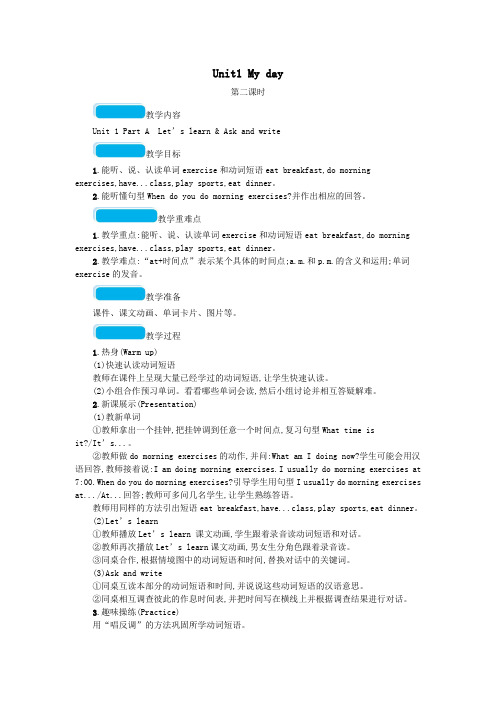
Unit1 My day第二课时教学内容Unit 1 Part A Let’s learn & Ask and write教学目标1.能听、说、认读单词exercise和动词短语eat breakfast,do morning exercises,have...class,play sports,eat dinner。
2.能听懂句型When do you do morning exercises?并作出相应的回答。
教学重难点1.教学重点:能听、说、认读单词exercise和动词短语eat breakfast,do morning exercises,have...class,play sports,eat dinner。
2.教学难点:“at+时间点”表示某个具体的时间点;a.m.和p.m.的含义和运用;单词exercise的发音。
教学准备课件、课文动画、单词卡片、图片等。
教学过程1.热身(Warm up)(1)快速认读动词短语教师在课件上呈现大量已经学过的动词短语,让学生快速认读。
(2)小组合作预习单词。
看看哪些单词会读,然后小组讨论并相互答疑解难。
2.新课展示(Presentation)(1)教新单词①教师拿出一个挂钟,把挂钟调到任意一个时间点,复习句型What time isit?/It’s...。
②教师做do morning exercises的动作,并问:What am I doing now?学生可能会用汉语回答,教师接着说:I am doing morning exercises.I usually do morning exercises at 7:00.When do you do morning exercises?引导学生用句型I usually do morning exercises at.../At...回答;教师可多问几名学生,让学生熟练答语。
教师用同样的方法引出短语eat breakfast,have...class,play sports,eat dinner。
Unit1Myday第二课时(教案)-人教PEP版英语五年级下册
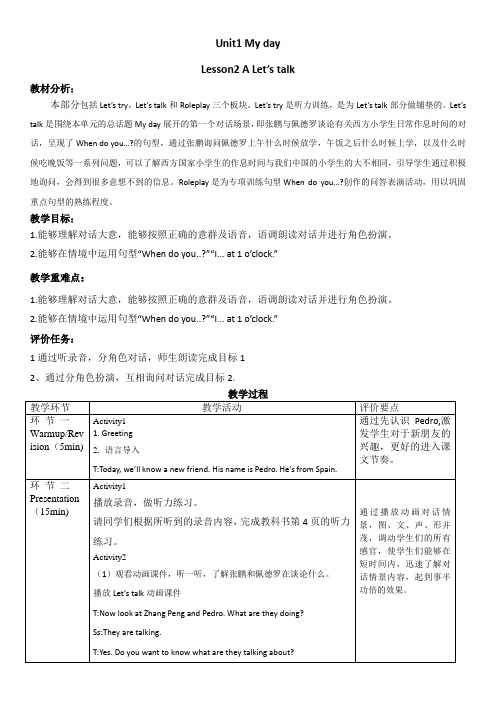
Unit1 My dayLesson2 A Let’s talk教材分析:本部分包括Let’s try,Let’s talk和Roleplay三个板块。
Let’s try是听力训练,是为Let’s talk部分做铺垫的。
Let’s talk是围绕本单元的总话题My day展开的第一个对话场景,即张鹏与佩德罗谈论有关西方小学生日常作息时间的对话,呈现了When do you…?的句型,通过张鹏询问佩德罗上午什么时候放学,午饭之后什么时候上学,以及什么时候吃晚饭等一系列问题,可以了解西方国家小学生的作息时间与我们中国的小学生的大不相同,引导学生通过积极地询问,会得到很多意想不到的信息。
Roleplay是为专项训练句型When do you…?创作的问答表演活动,用以巩固重点句型的熟练程度。
教学目标:1.能够理解对话大意,能够按照正确的意群及语音,语调朗读对话并进行角色扮演。
2.能够在情境中运用句型“When do you..?”“I... at 1 o’clock.”教学重难点:1.能够理解对话大意,能够按照正确的意群及语音,语调朗读对话并进行角色扮演。
2.能够在情境中运用句型“When do you..?”“I... at 1 o’clock.”评价任务:1通过听录音,分角色对话,师生朗读完成目标12、通过分角色扮演,互相询问对话完成目标2.板书设计:Unit1 My dayLesson2 A Let’s talkafter,start,SpainWhen do you finish class in the morning?We finish class at 1 o’clock.课后反思。
Unit 1 My day第二课时教案
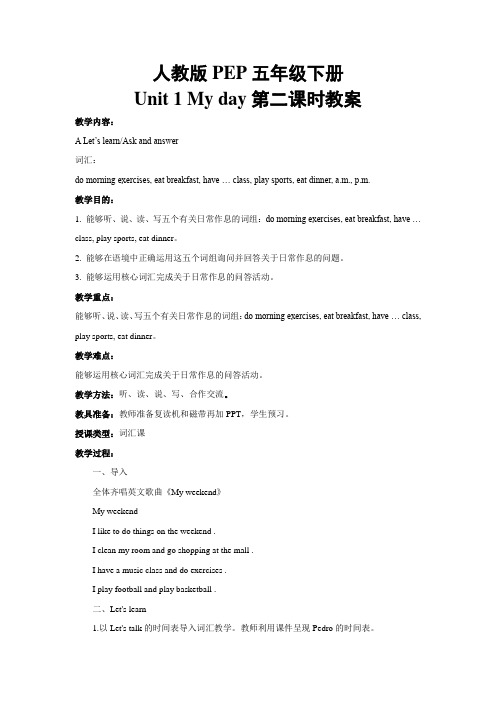
人教版PEP五年级下册Unit 1 My day第二课时教案教学内容:A Let’s learn/Ask and answer词汇:do morning exercises, eat breakfast, have … class, play sports, eat dinner, a.m., p.m.教学目的:1. 能够听、说、读、写五个有关日常作息的词组:do morning exercises, eat breakfast, have … class, play sports, eat dinner。
2. 能够在语境中正确运用这五个词组询问并回答关于日常作息的问题。
3. 能够运用核心词汇完成关于日常作息的问答活动。
教学重点:能够听、说、读、写五个有关日常作息的词组:do morning exercises, eat breakfast, have … class, play sports, eat dinner。
教学难点:能够运用核心词汇完成关于日常作息的问答活动。
教学方法:听、读、说、写、合作交流。
教具准备:教师准备复读机和磁带再加PPT,学生预习。
授课类型:词汇课教学过程:一、导入全体齐唱英文歌曲《My weekend》My weekendI like to do things on the weekend .I clean my room and go shopping at the mall .I have a music class and do exercises .I play football and play basketball .二、Let's learn1.以Let's talk的时间表导入词汇教学。
教师利用课件呈现Pedro的时间表。
Pedro's Timetableget up often at 7 o'clockstart class usually at 9 o'clock finish class in the morning at 1 o'clockgo back to school after lunch at 2:30start class in the afternoon at 3 o'clockeat dinner usually at 9:30 or 10 o'clock 教师请学生扮演Pedro,运用Let's talk板块的核心句型和几位学生进行问答练习,对话示例如下:T:Hi ,Pedro. When do you get up?S1:I often get up at 7 o'clock.T:When do you eat dinner?S2:……接着教师请学生两人一组讨论。
人教PEP版五下《Unit1 My day》(Part A第2课时)教学设计
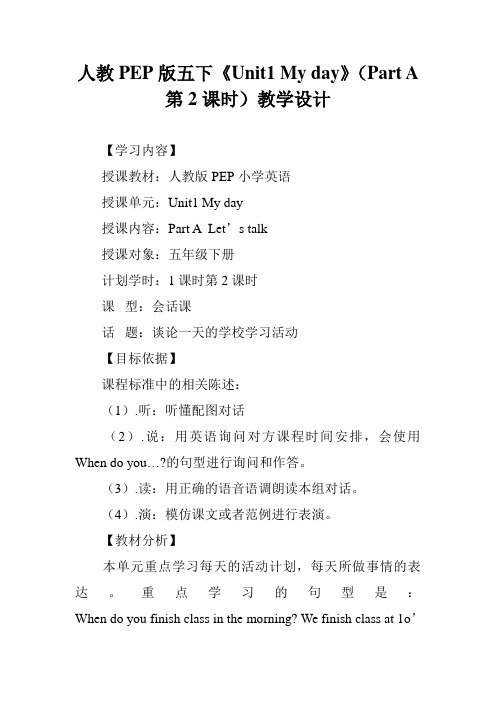
人教PEP版五下《Unit1 My day》(Part A第2课时)教学设计【学习内容】授课教材:人教版PEP小学英语授课单元:Unit1 My day授课内容:Part A Let’s talk授课对象:五年级下册计划学时:1课时第2课时课型:会话课话题:谈论一天的学校学习活动【目标依据】课程标准中的相关陈述:(1).听:听懂配图对话(2).说:用英语询问对方课程时间安排,会使用When do you…?的句型进行询问和作答。
(3).读:用正确的语音语调朗读本组对话。
(4).演:模仿课文或者范例进行表演。
【教材分析】本单元重点学习每天的活动计划,每天所做事情的表达。
重点学习的句型是:When do you finish class in the morning? We finish class at 1o’clock.【学情分析】五年级的学生经过两年多的英语学习,已经有了很好的英语基础。
他们聪明活泼,勤奋好学,对英语有着浓厚的学习兴趣。
因此,我确立以下的学习目标:【学习目标】1.正确朗读A部分Let’s talk 部分中的对话。
并能在实际情景中运用。
能够正确使用usually这个频度副词。
听懂Let’s try部分的录音,完成听音找答案的练习。
2.在Role play部分用本课时目标语言询问同学的作息时间,并能对结果做简单的反思。
3.运用已学知识进行课文的重新创编【学习重点】1.听、说、认读“classes start”和“finish class”。
2.听懂、会说句子“When do you finish class in the morning? We finish class at 1o ’clock.”【学习难点】1. 能灵活运用句型“When do you…?”询问他人的日常活动并作出相应的回答。
2. 会创编新的对话,并用在合适的场景里面。
【教学工具】教师准备多媒体课件、录音机和录音带、词卡。
人教PEP英语五下Unit1Thisismyday教案课时2
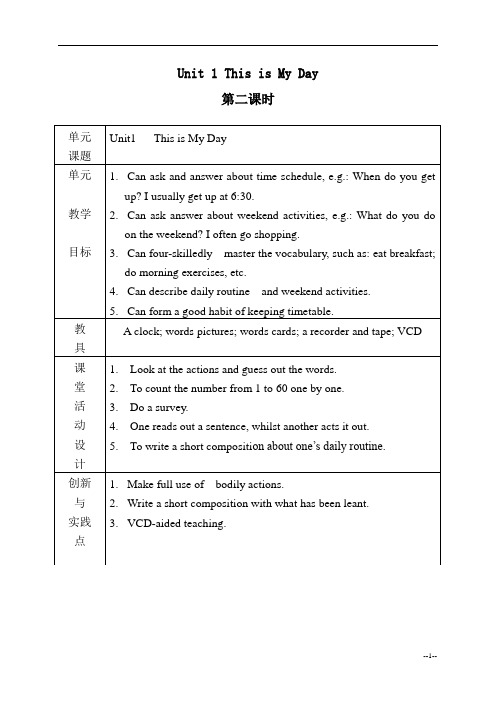
教
学
过
程
1.Warm up
1) Greeting
2) Let’s sing
2.Review
1) Look at the picture and read the words.
2) Ask and answer in a chain:
A: When do you get up?
3.VCD-aided teaching.
Unit 1 This is My Day
第二课时
第
二
课
时
教学
内容
与
重难点
1.Teaching content: Let’s try, let’s talk, andlet’s find out, andlet’s sing.
2.Key point: When do you get up? I usually…
5.To write a short composition about one’s daily routine.
创新
与
实践
点
1.Make full use of bodily actions.
2.Write a short composition with what has been leant.
3.Can four-skilledly master the vocabulary, such as: eat breakfast; do morning exercises, etc.
4.Can describe daily routine and weekend activities.
5.Can form a good habit of keeping timetable.
人教PEP版英语五年级下册Unit1《MyDay》全单元课时教学设计
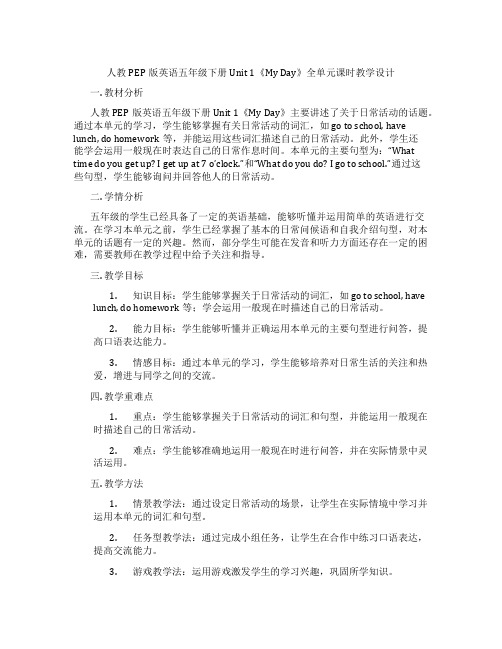
人教PEP版英语五年级下册Unit 1《My Day》全单元课时教学设计一. 教材分析人教PEP版英语五年级下册Unit 1《My Day》主要讲述了关于日常活动的话题。
通过本单元的学习,学生能够掌握有关日常活动的词汇,如go to school, have lunch, do homework等,并能运用这些词汇描述自己的日常活动。
此外,学生还能学会运用一般现在时表达自己的日常作息时间。
本单元的主要句型为:“What time do you get up? I get up at 7 o’clock.”和“What do you do? I go to school.”通过这些句型,学生能够询问并回答他人的日常活动。
二. 学情分析五年级的学生已经具备了一定的英语基础,能够听懂并运用简单的英语进行交流。
在学习本单元之前,学生已经掌握了基本的日常问候语和自我介绍句型,对本单元的话题有一定的兴趣。
然而,部分学生可能在发音和听力方面还存在一定的困难,需要教师在教学过程中给予关注和指导。
三. 教学目标1.知识目标:学生能够掌握关于日常活动的词汇,如go to school, havelunch, do homework等;学会运用一般现在时描述自己的日常活动。
2.能力目标:学生能够听懂并正确运用本单元的主要句型进行问答,提高口语表达能力。
3.情感目标:通过本单元的学习,学生能够培养对日常生活的关注和热爱,增进与同学之间的交流。
四. 教学重难点1.重点:学生能够掌握关于日常活动的词汇和句型,并能运用一般现在时描述自己的日常活动。
2.难点:学生能够准确地运用一般现在时进行问答,并在实际情景中灵活运用。
五. 教学方法1.情景教学法:通过设定日常活动的场景,让学生在实际情境中学习并运用本单元的词汇和句型。
2.任务型教学法:通过完成小组任务,让学生在合作中练习口语表达,提高交流能力。
3.游戏教学法:运用游戏激发学生的学习兴趣,巩固所学知识。
小学英语五年级下册《Unit 1 My day》教学设计(人教PEP版)
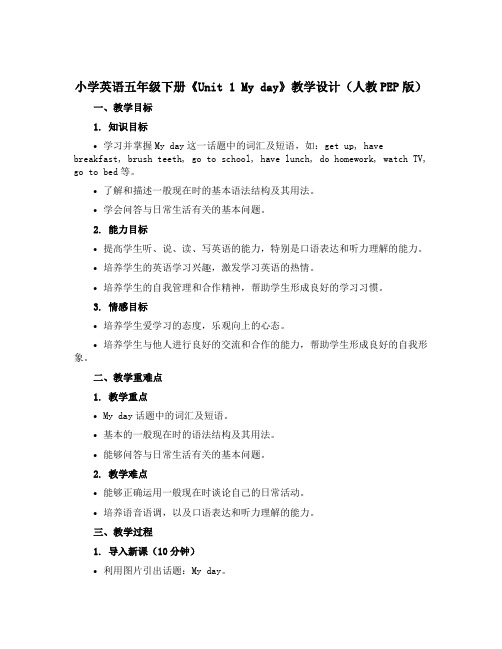
小学英语五年级下册《Unit 1 My day》教学设计(人教PEP版)一、教学目标1. 知识目标•学习并掌握My day这一话题中的词汇及短语,如:get up, have breakfast, brush teeth, go to school, have lunch, do homework, watch TV, go to bed等。
•了解和描述一般现在时的基本语法结构及其用法。
•学会问答与日常生活有关的基本问题。
2. 能力目标•提高学生听、说、读、写英语的能力,特别是口语表达和听力理解的能力。
•培养学生的英语学习兴趣,激发学习英语的热情。
•培养学生的自我管理和合作精神,帮助学生形成良好的学习习惯。
3. 情感目标•培养学生爱学习的态度,乐观向上的心态。
•培养学生与他人进行良好的交流和合作的能力,帮助学生形成良好的自我形象。
二、教学重难点1. 教学重点•My day话题中的词汇及短语。
•基本的一般现在时的语法结构及其用法。
•能够问答与日常生活有关的基本问题。
2. 教学难点•能够正确运用一般现在时谈论自己的日常活动。
•培养语音语调,以及口语表达和听力理解的能力。
三、教学过程1. 导入新课(10分钟)•利用图片引出话题:My day。
•让学生通过图片描述“洗脸”、“刷牙”等日常活动,引导学生进入Myday这一话题。
•引导学生回答问题:“What do you usually do in the morning?”2. 新课讲解(30分钟)•通过图片和语音练习帮助学生学习词汇及短语,如:get up, have breakfast, brush teeth, go to school, have lunch, do homework, watch TV, go to bed等。
•通过示范和训练,教授一般现在时的语法结构及其用法,包括:主语+动词原形+其他,例如:I get up at six o’clock. He goes to school by bus. They have lunch at noon.等。
人教版五年级下册英语 Unit 1 My day第二课时教案
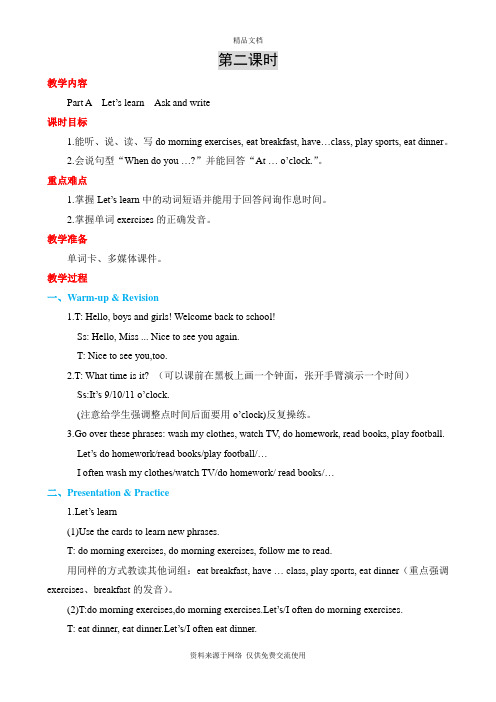
第二课时教学内容Part A Let’s learn Ask and write课时目标1.能听、说、读、写do morning exercises, eat breakfast, have…class, play sports, eat dinner。
2.会说句型“When do you …?”并能回答“At …o’clock.”。
重点难点1.掌握Let’s learn中的动词短语并能用于回答问询作息时间。
2.掌握单词exercises的正确发音。
教学准备单词卡、多媒体课件。
教学过程一、Warm-up & Revision1.T: Hello, boys and girls! Welcome back to school!Ss: Hello, Miss ... Nice to see you again.T: Nice to see you,too.2.T: What time is it? (可以课前在黑板上画一个钟面,张开手臂演示一个时间)Ss:It’s 9/10/11 o’clock.(注意给学生强调整点时间后面要用o’cl ock)反复操练。
3.Go over these phrases: wash my clothes, watch TV, do homework, read books, play football.Let’s do homework/read books/play football/…I often wash my clothes/watch TV/do homework/ read books/…二、Presentation & Practice1.Let’s learn(1)Use the cards to learn new phrases.T: do morning exercises, do morning exercises, follow me to read.用同样的方式教读其他词组:eat breakfast, have … class, play sports, eat dinner(重点强调exercises、breakfast的发音)。
五年级英语下册Unit1MydayPartA第二课时教案1人教PEP
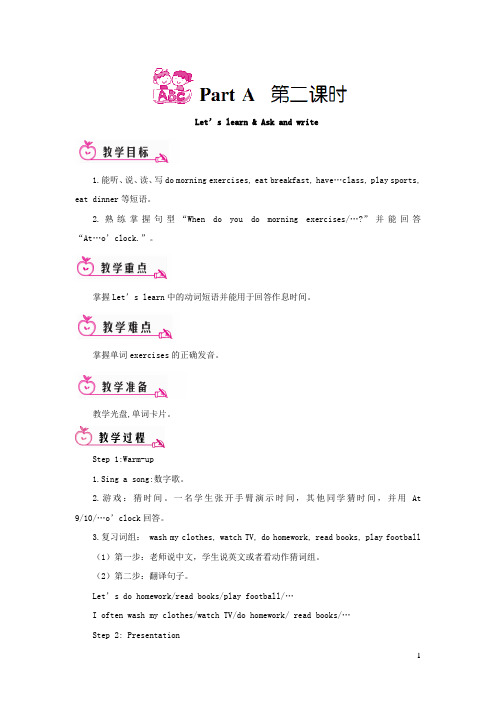
Let’s learn & Ask and write1.能听、说、读、写do morning exercises, eat breakfast, have…class, play sports, eat dinner等短语。
2.熟练掌握句型“When do you do morning exercises/…?”并能回答“At…o’clock.”。
掌握Let’s learn中的动词短语并能用于回答作息时间。
掌握单词exercises的正确发音。
教学光盘,单词卡片。
Step 1:Warm-up1.Sing a song:数字歌。
2.游戏:猜时间。
一名学生张开手臂演示时间,其他同学猜时间,并用At 9/10/…o’clock回答。
3.复习词组: wash my clothes, watch TV, do homework, read books, play football(1)第一步:老师说中文,学生说英文或者看动作猜词组。
(2)第二步:翻译句子。
Let’s do homework/read books/play football/…I often wash my clothes/watch TV/do homework/ read books/…Step 2: Presentation1.用卡片来学习新短语,教师做动作或者PPT出示图片引出词组并指名读,请发音标准的学生领读。
2.让学生根据自己的时间,对刚刚所学的动词短语进行练习。
3.教师在学生口述的时候,可以不失时机地追问,如:T: When do you do morning exercises /play football/play sports?Ss:I do morning exercises/play football/play sports at…o’clock./At…o’clock.(向学生强调具体时刻前要用介词at)4.介绍新单词usually,并运用到句子中:I usually…5.组织学生模仿Let’s learn部分进行对话。
- 1、下载文档前请自行甄别文档内容的完整性,平台不提供额外的编辑、内容补充、找答案等附加服务。
- 2、"仅部分预览"的文档,不可在线预览部分如存在完整性等问题,可反馈申请退款(可完整预览的文档不适用该条件!)。
- 3、如文档侵犯您的权益,请联系客服反馈,我们会尽快为您处理(人工客服工作时间:9:00-18:30)。
The second periodPart A Let’s learn & Ask and write内容分析本课时为PEP五年级下册Unit 1的第二课时,依然围绕“询问对方一天中的作息时间”这个话题展开内容。
Let’s learn是呈现Pedro一天的活动作息图片与时间信息,还有一组问答句,使学生们进一步了解西班牙小学生的具体的日常生活作息情况。
Ask and write呈现的是有关伙伴的日常活动作息表格,鼓励学生运用When do you ...?句型,采用问答方式,获得小伙伴们的完整信息,最终完成表格内容的填充任务。
课时目标知识与能力1.够听、说、读、写以下短语:do morning exercises, eat breakfast, have class, play sports, eat dinner。
2.能够运用句型“—When do you do morning exercises / …? —I usually at ” 询问和回答日常活动的时间安排。
3.能够学会合理安排作息,珍惜时间,养成良好的作息习惯。
4.能够在语境中正确运用重点短语及句型。
5.能够关心或了解同学的日常生活安排。过程与方法通过TPR 热身活动,复习之前学过的动词短语,帮助学生迅速进入状态,为教授新的短语做好铺垫。
让学生扮演Pedro,用第一人称回答作息时间安排,非常有代入感。
了解Pedro 的吃饭时间后,教师马上询问班上学生的真实作息时间安排,让所学知识融入学生生活,加深学生记忆。
呈现学生学过的教材封面,以贴近学生学习生活的方式,让学生学习“have…class”,真实而又自然。
通过由易到难的游戏活动,激发学生的竞争意识,进一步巩固所学新短语。
由词到句,逐步强化正确表达的能力。
情感态度价值观让学生在尽量真实的语境中合理运用所学词汇和句型,培养学生的综合语言运用能力,达到语言输出的目的。
教学重难点教学重点能够听、说、读、写本课时的五个动词短语。教学难点能够在实际语境中运用关于作息时间的句型“—When do you ?—I usually/often at ”进行交流。教学准备教学课件、课文视频等。
教学媒体选择多媒体,录音。
教学活动1.角色扮演;2.游戏;3.观看动画。
教学过程Step 1: Warm-up & Revision1. Greetings.2. TPR game. (出示课件)Show pictures of some activities. (e.g., watch TV, read books, listen to music, do homework…) Students do the actions and say the phrases quickly.T: Everybody, stand up. Let’s say and do quickly! Here we go!S1: Watch TV. (with action)S2: Read books. (with action)S3: Listen to music. (with action)S4: Water the flowers. (with action)S: …Step 2: Presentation1. Learn “do morning exercises” and “a.m.”.T: Look! Our new friend Pedro is coming. He is from Spain. What does he do every day? Let’ s have a look.(课件出示:Let’ s learn 做早操及其时间的图。
)T: What does Pedro do? (The teacher does the action.)Ss: Do morning exercises.T: Good! Do morning exercises.(Show the flash card, students read the phrase together. Then the teacher writes down “do morning exercises” on the blackboard. Ask students to pay attention to the pronunciation of “exercises”.)T: When does Pedro usually do morning exercises?Ss: At 7 o’ clock.T: Yes, at 7:00 a.m. (Write down “a.m.” on the blackboard.)T: “a. m.” means “in the morning”. When do you usually do morning exercises?Ss: At ________.T: Oh, you can say: I do morning exercises at ________a.m.2. Learn “eat breakfast”.(1) T: Class! You are Pedro now. Pedro, when do you eat breakfast?(课件出示:Let’ s learn 吃早饭及其时间的图。
)Ss: I eat breakfast at 8:00 a.m.Show the flash card, students read the phrase together. Then boys PK girls.(Write down “eat breakfast” on the blackboard.)T: I eat breakfast at 7:30 a.m. When do you eat breakfast, S1?S1: I eat breakfast at…T: What about you? S2, S3, S4…S2 / S3 / S4: I eat breakfast at(2) Pair work.Students do the pair work and then have a show.A: When do you eat breakfast?B: I eat breakfast at .3. Learn “have…class”.(1) Show the class schedule on Monday. (课件出示:一张星期一的课程安排表。
)T: Today is Monday. What class do you have on Mondays?Ss: We have Chinese / English / maths / class.T: Pedro, when do you have English class?(课件出示:Let’ s learn 上英语课及其时间的图。
)Ss: I have English class at 9:00 a.m.(Write down “have…class” on the blackboard.)Students read after the teacher. The teacher checks the pronunciation.(2) Show some covers of the textbooks. Let students practise “have…class”. (课件出示:一些学科的教材封面图。
)4. Learn “play sports” and “p.m.”.(课件出示:Let’ s learn 做运动及其时间的图。
)T: Pedro, we have studied all day. Let’ s play sports together.(Write down “play sports” on the blackboard.)Students read after the teacher.T: Pedro, when do you play sports?Ss: I play sports at 6:00 p.m.T: Good! “p.m.” means “in the afternoon”.(Write down “p.m.” on the blackboard.)The teacher takes out a toy ball and throws it to S1.T: S1, when do you play sports?S1: I play sports atT: Great! Pass the ball to the next one and ask him or her, “When do you play sports?”S1: When do youS2: …S3: ……5. Learn “eat dinner”.(课件出示:Let’ s learn 吃晚饭及其时间的图。
)T: After playing sports, I am tired and hungry. It’s time to eat dinner.(Write down “eat dinner” on the blackboard.)Students read after the teacher.T: Pedro, when do you eat dinner?Ss: I eat dinner at 9:00 p.m.T: Oh, that’s too late! S1, when do you eat dinner?S1: I eat dinner at ________p.m.6. Listen and read.Students read the phrases and sentences after the recording.7. Introduce Pedro’ s timetable.(课件出示:Petro 的时间安排表。
)T: You can say like this:Hello! I’m Pedro. At 7:00 a.m., I ________. At ________, I ________.Step 3: Practice1. Play games.(1) Bomb game.If there is no bomb, students can say the phrases loudly. If there is a bomb with a phrase, students should keep silent.(2) Can you say?Show the pictures of different activities and time. Students look and fill in the sentences.2. Ask and answer.(1) Pair work.S1: When do you…?S2: I ________at ________. When do you...?S1: I ________at ________.(2) Group work.Work in groups of four. Each group asks and answers questions in turn.Step 4: Consolidation & ExtensionWhat is an ideal timetable?(1) Look and say.Show some pictures of unhealthy timetable. Ask students to judge they are good or bad and give their reasons. (课件出示:一些不健康的作息图片。
